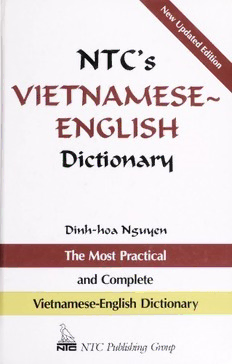
NTC’s Vietnamese-English dictionary PDF
Preview NTC’s Vietnamese-English dictionary
NTC’s VIETNAMESE ENGLISH PictioiAni *N$u\\cn The Most Practical and Complete Vietnamese-English Dictionary NTC m!5 Group Publishing NTC’S VIETNAMESE- ENGLISH DICTIONARY NTC's VIETNAMESE' ENGLISH DICTIONARY NI C Publishing Group Congress Cataloging-in-Publication Data Library of Nguyen, Dinh Hoa, 1924- NTC’s Vietnamese-English dictionary / Dinh-hoa Nguyen, cm. p. — ISBN 0-8442-8356-8 ISBN 0-8442-8357-6 1. Vietnamese language—Dictionaries—English. I. Title. PL4376.N345 1995 — 95-18670 495.92'2321 dc20 CIP Published by NTC Publishing Group A division of NTC/Contemporary Publishing Group, Inc. 4255 West Touhy Avenue, Lincolnwood (Chicago), Illinois 60646-1975 U.S.A. Copyright © 1995 by NTC/Contemporary Publishing Group, Inc. All rights reserved. No part of this book may be reproduced, stored in a retrieval system, or transmitted in any form or by any means, electronic, mechanical, photocopying, recording, or otherwise, without the prior permission of NTC/Contemporary Publishing Group, Inc. Printed in the United States of America International Standard Book Number: 0-8442-8356-8 ISBN 0-8442-8357-6 19 18 17 16 15 14 13 12 11 10 9 8 7 6 5 4 3 CONTENTS Preface vii Guide to Pronunciation ix Dictionary 1 Supplement 679 PREFACE This student’s dictionary, whose aim it is to provide a convenient reference work for the increasing number of English- speaking students of Vietnamese, is an enlargement of the author’s Vietnamese-Englisb Dictionary published in Saigon. Efforts have been made to glean abundant compounds from newspapers and periodicals, government releases and modern textbooks. As in the earlier edition, the corpus includes both morphemes and words. It is well known that, whereas each Vietnamese morpheme always coincides with a separately written syllable, a morpheme or monosyllable does not always constitute a syntactic word. We continue, therefore, to list reduplicative forms (DUP) such as buo'm-birfrm, additive forms such as but nghien, verb- object compounds such as an tien, Sino-Vietnamese compounds, — and other polysyllabic loan-words from French, Malay, etc., — as independent entries, and not as subentries. As for those morpheme which are not entirely freely used within the syntactic framework of the language, they are marked as bound or restricted R ]. Equivalents of Chinese-borrowed lexical [ items are given whenever it is thought useful to do so ; e. g. kh&u R mouth, opening = mi£ng The full significance of this ]. [ symbol R (read « restricted » or « nearly always restricted » or <- not occurring alone is twofold (i) such an item as khau is never ><) : used by itself, but only in compounds, e. g., hdi-khau mouth of — — the sea, seaport, nhap-khau to enter port, to import, etc. ; and (2) it is not used freely everywhere its native equivalents mieng and mum are found. (One says mi^ng toi, but not khau toi for 'my mouth’.) In addition « - R '» tells us that the item is used as suffix whereas « R - » means that the entry in question is affixed to a stem following For instance, hda when used as a suffix (position it. -R) means To make, -ize, -fy', as in Vi$t-hoa 'to 'detnamize , Au- hda ‘to europeanize’. Such an item as vo occurring as a prefix. VIII denotes 'to be without, un-, -less’, as in vo-ich 'useless*, vo-can-cir groundless*. Items found only in literary contexts are marked L, and reversible compounds are marked with an asterisk, e. g., bio-ddm. Nouns are as often as possible shown with their respective classifiers, that is to say, words which should precede them in numeration. Thus giay 'shoe* is shown as « classified with CL [ ] chitc for 'one shoe’ and doi for 'a pair of shoes’, » Each classifier* in turn, is explained as « classifier for nouns denoting... » [ CL for ]. When an item serves more than one grammatical function, a vertical or single bar appears between such different meanings ; i.e.. cay to plow plow CL cai. | Interchangeable items are separated by a slash e.g., n6i den/toi : to speak of. Synonyms [=], antonyms [^], and items to be compared [Cf are also provided. The symbol [RV] means that .] what follows it is usedas a resultative verb of the main verb, e.g., di 'to go', which accompanies the verb vfrt 'to throw’ to yield 'to throw away*. When a compound or phrase is listed immediatedy following the — English equivalent of a monosyllabic entry which may or may not — be a bound morpheme that compound or phrase, if used freely, has the same meaning as the entry itself. For example, "hau in R order to ng5 hau”, "bien to spread, popularize pho-bien”. The order we follow in listing our entries is the traditional one, namely, a 2, a, b, c, ch, d, d, e, e, g, (and gh), gi, h, i, k, kh, 1, m, n, ng (and ngh), nh, o, 6, o', p, q, ph, qu, r, s, t, th, tr, u, ir, v, x, and y. The order for the tones is as follows : level (unmarked), high rising ('), low falling ('), low rising ('), high rising broken (**), and low broken or constricted ( # ), i.e., in Vietnamese, ngang, s4c, huyen, hoi, nga, and nang respectively. A guide to Vietnamese pronunciation is supplied following this preface and a 50-page supplement of new Vietnamese words and meanings follows the dictionary. N.D.H.
